The 1968 Chevrolet Chevelle, a name synonymous with American muscle car heritage, burst onto the scene with a powerful roar and a sleek, stylish design. This iconic model captured the hearts of enthusiasts and became a cultural symbol of the era.
The Chevelle’s appeal stemmed from its potent engine options, impressive performance, and a wide range of trim levels catering to diverse preferences. From the sporty SS to the luxurious Concours, there was a Chevelle for every driver.
The 1968 Chevelle was a testament to General Motors’ engineering prowess and its ability to blend power and sophistication. Its design, a blend of sharp lines and flowing curves, was both timeless and modern. The Chevelle’s success was undeniable, with its popularity soaring as it became a mainstay on the streets and racetracks of America.
Its impact extended beyond the automotive world, making appearances in films and television shows, solidifying its place in popular culture.
Overview

The 1968 Chevrolet Chevelle, a mid-size car produced by Chevrolet, holds a significant place in automotive history. It marked the second generation of the Chevelle line, introducing a completely redesigned body style and a wider range of engine options. This generation, known for its sleek, muscular lines and performance capabilities, became a popular choice among American car buyers.The Chevelle’s design and styling were heavily influenced by the contemporary design trends of the late 1960s.
It featured a distinctive fastback roofline, a long hood, and a short rear deck, giving it a sporty and aggressive appearance. The car’s styling was also characterized by its prominent grille, which featured a horizontal chrome bar with the Chevrolet emblem in the center.
Target Market and Popularity
The 1968 Chevelle was designed to appeal to a broad range of buyers, from families seeking a comfortable and practical car to performance enthusiasts looking for a powerful and stylish ride. Its versatility and affordability contributed to its immense popularity during its release year.
The 1968 Chevrolet Chevelle, a classic muscle car, offered a range of powerful engine options and stylish designs. While the Chevelle was a standout in its own right, it’s worth noting the influence of its predecessor, the 1960 Chevrolet Impala , which helped to establish Chevrolet’s reputation for building iconic American automobiles.
The Chevelle continued this legacy, becoming a symbol of the muscle car era and a highly sought-after collectible today.
The Chevelle’s success was further amplified by its availability in various trim levels, including the Malibu, SS, and Concours, offering different levels of luxury and performance.
Engine Options and Performance: 1968 Chevrolet Chevelle
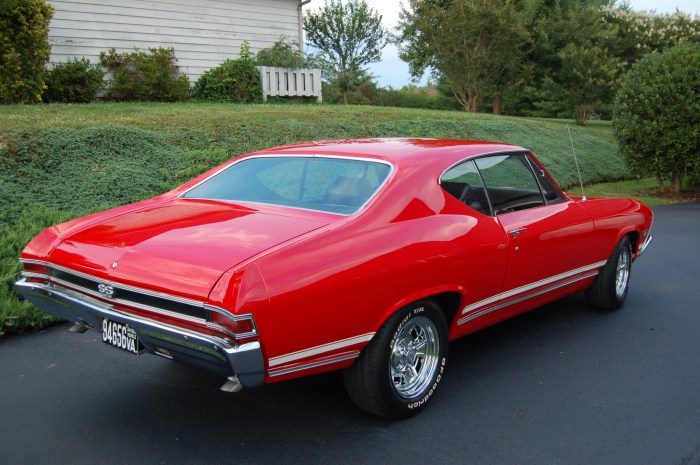
The 1968 Chevrolet Chevelle offered a wide range of engine options, catering to diverse driver preferences and performance desires. From economical six-cylinder units to powerful V8s, there was an engine to suit every need. This diverse selection contributed to the Chevelle’s popularity and versatility, making it a sought-after vehicle for both daily driving and spirited performance.
Engine Options
The 1968 Chevelle was available with a selection of six-cylinder and V8 engines.
- 230 cu in (3.8 L) Straight-6: This was the base engine, offering decent fuel economy but limited power. It produced 140 hp (104 kW) and 210 lb⋅ft (285 N⋅m) of torque.
- 250 cu in (4.1 L) Straight-6: A slightly larger six-cylinder engine, producing 155 hp (116 kW) and 230 lb⋅ft (312 N⋅m) of torque. This engine provided a balance of performance and economy.
- 307 cu in (5.0 L) Small-Block V8: This was the standard V8 option, delivering a significant power boost over the six-cylinder engines. It produced 200 hp (149 kW) and 280 lb⋅ft (380 N⋅m) of torque.
- 350 cu in (5.7 L) Small-Block V8: Available in various configurations, this engine offered a wide range of power outputs. It could be had with horsepower ratings ranging from 250 hp (186 kW) to 300 hp (224 kW), depending on the chosen carburetion and other modifications.
- 396 cu in (6.5 L) Big-Block V8: This was the top-of-the-line engine, delivering a thrilling performance experience. It was offered in two versions: a 325 hp (242 kW) version and a high-performance 375 hp (280 kW) version.
Performance Characteristics
The 1968 Chevelle’s performance varied greatly depending on the chosen engine. The base six-cylinder engines provided adequate power for daily driving, while the V8s offered exhilarating acceleration and top speed.
- Acceleration: The Chevelle with the 396 cu in (6.5 L) Big-Block V8 could achieve a 0-60 mph time of around 7 seconds, making it a quick and powerful car for its time. The 350 cu in (5.7 L) V8 also provided respectable acceleration, with 0-60 mph times in the low-to-mid 8-second range.
- Top Speed: The top speed of the Chevelle varied depending on the engine and gearing. The 396 cu in (6.5 L) Big-Block V8-powered Chevelles could reach speeds exceeding 120 mph. The 350 cu in (5.7 L) V8 models were also capable of reaching speeds over 100 mph.
- Handling: The Chevelle’s handling was generally considered good for its time. The suspension was designed to provide a comfortable ride while still offering adequate control during spirited driving. However, some drivers found the handling to be somewhat soft and less responsive than other muscle cars of the era.
Trim Levels and Features
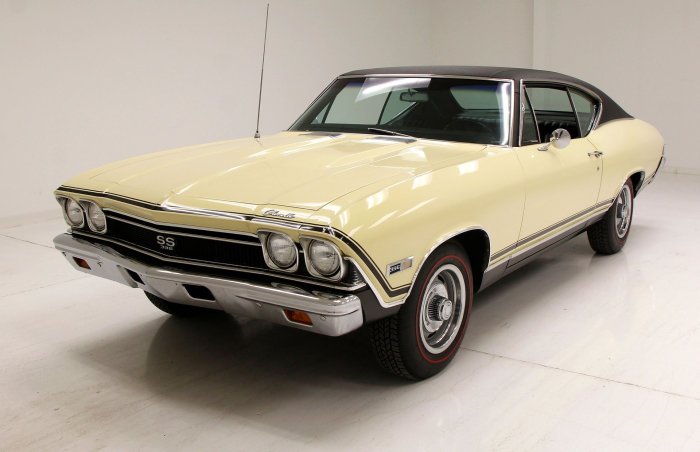
The 1968 Chevrolet Chevelle was offered in a variety of trim levels, each catering to different buyer preferences and budgets. From the basic 300 Deluxe to the sporty SS, there was a Chevelle to suit every need.
The 1968 Chevrolet Chevelle, a muscle car icon, represents a stark contrast to its earlier ancestor, the 1926 Chevrolet Pickup. While the Chevelle embodied the spirit of performance and style, the 1926 Pickup was a workhorse, built for utility and practicality.
The evolution from the utilitarian 1926 model to the powerful Chevelle highlights the changing landscape of American automotive design and the growing desire for speed and luxury.
Trim Levels
The 1968 Chevelle was available in several trim levels, each offering a distinct blend of features and styling.
- 300 Deluxe:The 300 Deluxe was the entry-level trim level, offering a no-frills approach to Chevelle ownership. It came standard with a 140-cubic-inch straight-six engine, a three-speed manual transmission, and basic interior and exterior features.
- Malibu:The Malibu was the mid-range trim level, offering a step up in comfort and style. It came standard with a 250-cubic-inch straight-six engine, a three-speed manual transmission, and a more upscale interior.
- Concours:The Concours was a luxurious trim level, designed to compete with other upscale mid-size cars of the time. It came standard with a 250-cubic-inch straight-six engine, a three-speed manual transmission, and a plush interior with features like vinyl upholstery and a woodgrain dashboard.
- SS:The SS (Super Sport) was the performance-oriented trim level, designed to appeal to enthusiasts. It came standard with a 396-cubic-inch V8 engine, a four-speed manual transmission, and a sporty exterior with features like a blacked-out grille and hood scoops.
Standard and Optional Features
Each trim level offered a variety of standard and optional features.
Standard Features
- 300 Deluxe:The 300 Deluxe came standard with basic features like a vinyl bench seat, a single-speed windshield wiper, and a basic radio.
- Malibu:The Malibu offered more comfort features like a padded dashboard, a two-speed windshield wiper, and a more upscale radio.
- Concours:The Concours came standard with luxury features like vinyl upholstery, a woodgrain dashboard, and a power steering option.
- SS:The SS offered performance-oriented features like a heavy-duty suspension, a floor-mounted shifter, and a sport steering wheel.
Optional Features
A wide range of optional features were available across all trim levels, allowing buyers to customize their Chevelles. These options included:
- Power steering:This option provided easier steering, especially in city driving.
- Power brakes:This option provided quicker and more responsive braking.
- Automatic transmission:This option provided smoother and more convenient driving.
- Air conditioning:This option provided welcome relief from the summer heat.
- Vinyl roof:This option added a touch of elegance and sophistication to the Chevelle.
- Bucket seats:This option provided more comfort and support for the driver and front passenger.
- Console:This option added a sporty touch to the interior and provided a convenient location for storage and controls.
Price and Availability
The price of a 1968 Chevelle varied depending on the trim level and options chosen. The 300 Deluxe was the most affordable option, while the SS was the most expensive. The availability of certain trim levels and options also varied depending on the region and dealer.
Historical Significance and Legacy
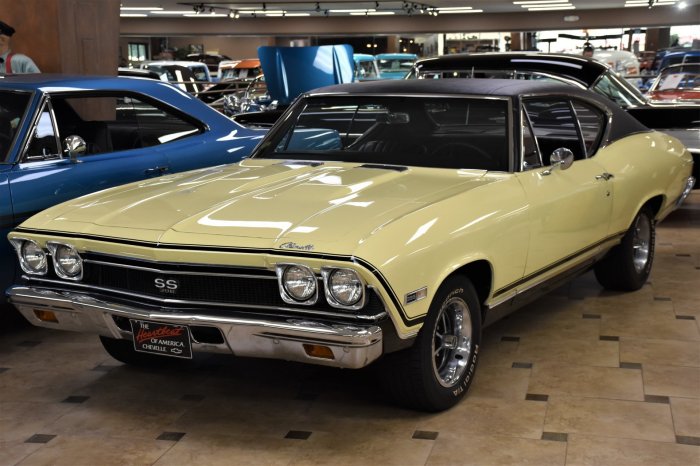
The 1968 Chevrolet Chevelle holds a significant place in automotive history, not only for its impressive performance and stylish design but also for its cultural impact and enduring legacy. This model played a pivotal role in shaping the muscle car era and left an indelible mark on popular culture, influencing subsequent generations of Chevrolet vehicles.
Cultural Impact and Popular Culture
The 1968 Chevelle’s influence extended beyond the realm of automotive engineering, making its mark on popular culture and becoming a symbol of the era. The car’s sleek design and powerful engine captured the spirit of the times, and its association with youth, rebellion, and freedom resonated with a generation.
- The Chevelle’s popularity was further cemented by its frequent appearances in movies and television shows, often portraying a sense of adventure and excitement. For instance, the 1968 Chevelle SS 396 was featured in the 1971 film “Dirty Mary, Crazy Larry,” showcasing its performance capabilities and adding to its mystique.
- The Chevelle also became a favorite among car enthusiasts and collectors, its timeless design and historical significance making it a sought-after classic. The car’s enduring appeal is evident in its continued presence at car shows and auctions, where it often commands impressive prices.
Racing Success and Achievements
The 1968 Chevelle’s performance prowess was not confined to the streets; it also excelled on the racetrack, achieving notable victories and establishing its reputation as a formidable competitor. The Chevelle’s success in racing contributed to its overall popularity and solidified its status as a true muscle car.
- One of the most notable racing achievements of the 1968 Chevelle was its victory in the NASCAR Grand National Series, driven by David Pearson. This victory showcased the Chevelle’s durability and performance capabilities, further enhancing its reputation among racing enthusiasts.
- The Chevelle’s racing success also extended to other series, including the NHRA, where it consistently performed well in both stock and modified classes. These victories solidified the Chevelle’s reputation as a versatile and capable racing machine, further contributing to its overall appeal.
Legacy and Influence on Subsequent Chevrolet Models
The 1968 Chevelle’s legacy continues to resonate with Chevrolet, influencing the design and performance of subsequent models. The Chevelle’s success paved the way for a lineage of muscle cars that carried the Chevrolet name into the future.
- The Chevelle’s design elements, such as its sleek lines and distinctive grille, served as inspiration for later Chevrolet models, including the Monte Carlo and the Malibu. These models retained the essence of the Chevelle’s design while incorporating modern features and technologies.
The 1968 Chevrolet Chevelle, with its sleek lines and powerful engine options, became a popular choice for both everyday driving and performance enthusiasts. While the Chevelle focused on a sporty appeal, Chevrolet also offered a rugged alternative in the form of the 1980 Chevrolet C10 , a pickup truck known for its durability and hauling capabilities.
Both vehicles represented distinct segments of the Chevrolet lineup, each appealing to a different set of needs and preferences.
- The Chevelle’s performance legacy also lived on in subsequent Chevrolet models, such as the Camaro and the Corvette. These cars, with their powerful engines and performance-oriented design, carried the torch of the Chevelle, embodying the spirit of American muscle.
Collecting and Restoring a 1968 Chevelle
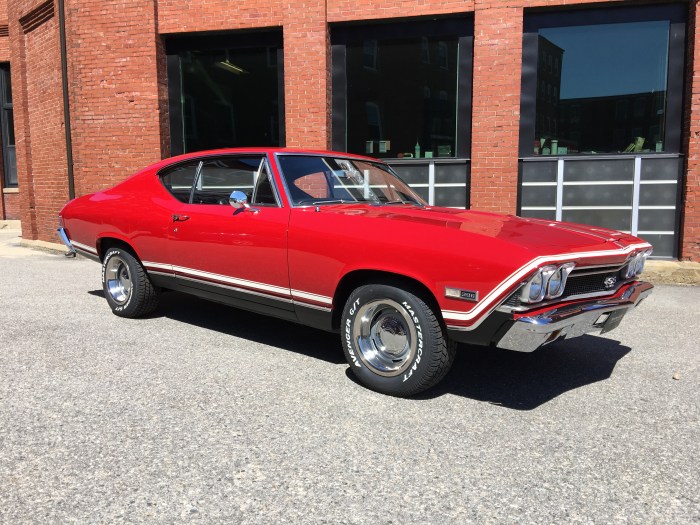
The 1968 Chevrolet Chevelle is a highly sought-after classic car, and for good reason. Its timeless design, powerful engine options, and iconic status have made it a favorite among collectors and enthusiasts. If you’re thinking about adding a 1968 Chevelle to your garage, you’ll need to know how to identify an authentic car and assess its condition before making a purchase.
Once you’ve found the right Chevelle, you’ll need to know how to restore it to its former glory.
Identifying Authentic 1968 Chevelles
Identifying an authentic 1968 Chevelle is essential to ensure you’re investing in a genuine classic. While many Chevelles have been meticulously restored, others may have been modified or even completely rebuilt. To avoid disappointment, here are some tips for identifying an authentic 1968 Chevelle:
- Check the VIN Number:The Vehicle Identification Number (VIN) is a unique identifier for every car, and it’s a crucial tool for verifying authenticity. The VIN for a 1968 Chevelle is located on the driver’s side dashboard, near the windshield. You can use the VIN to cross-reference the car’s history and confirm its originality.
- Inspect the Body Panels:The body panels of a 1968 Chevelle are a good indicator of its authenticity. Original body panels will have consistent fit and finish, with minimal gaps or misalignments. Look for signs of replacement panels, which may have different paint or a different texture.
- Examine the Engine and Drivetrain:The engine and drivetrain are also important indicators of authenticity. Check for original components, such as the engine block, transmission, and rear axle. If these components have been replaced, it’s important to know the reason for the replacement and the source of the replacement parts.
- Research the History:If possible, try to trace the history of the Chevelle. This can help you determine its original equipment and any modifications that have been made over the years.
Assessing the Condition of a 1968 Chevelle
Once you’ve identified an authentic 1968 Chevelle, you’ll need to assess its condition. This will help you determine the scope of any restoration work that needs to be done and the overall value of the car. Here are some tips for assessing the condition of a 1968 Chevelle:
- Body and Paint:Inspect the body for rust, dents, and scratches. Look for signs of previous repairs, such as filler or bodywork. Examine the paint for fading, chips, and cracks.
- Interior:Check the interior for wear and tear on the seats, carpets, and dashboard. Look for signs of damage or water leaks.
- Engine and Drivetrain:Start the engine and listen for any unusual noises. Check the engine oil and coolant levels. Inspect the transmission and rear axle for leaks or signs of wear.
- Undercarriage:Inspect the undercarriage for rust, damage, and leaks. Pay attention to the suspension components, brakes, and exhaust system.
Restoring a 1968 Chevelle
Restoring a 1968 Chevelle can be a rewarding but challenging project. Here are some tips for restoring a 1968 Chevelle, including common restoration challenges and recommended resources:
- Develop a Restoration Plan:Before you begin restoring a 1968 Chevelle, it’s important to have a clear plan. This will help you stay organized and on budget.
- Gather the Right Tools and Equipment:You’ll need a variety of tools and equipment to restore a 1968 Chevelle. This may include basic hand tools, power tools, a garage or workspace, and specialized equipment for bodywork and paint.
- Find Quality Parts:Finding quality parts for a 1968 Chevelle can be challenging. There are many suppliers that specialize in classic car parts, but it’s important to research and compare prices.
- Choose a Restoration Shop:If you’re not comfortable doing the restoration work yourself, you can choose a reputable restoration shop.
- Common Restoration Challenges:Some common restoration challenges for a 1968 Chevelle include finding original parts, rust repair, bodywork, and paint.
- Recommended Resources:There are many resources available to help you restore a 1968 Chevelle. These include online forums, books, magazines, and restoration shops.
Value and Desirability of 1968 Chevelle Models and Trim Levels
The value and desirability of different 1968 Chevelle models and trim levels vary depending on a number of factors, including condition, rarity, and desirability. Here are some of the most desirable 1968 Chevelle models and trim levels:
- SS 396:The SS 396 was the top-of-the-line performance model, featuring a powerful 396 cubic inch V8 engine.
- SS 396 Convertible:The SS 396 convertible was a rare and desirable model, with only a limited number produced.
- Malibu:The Malibu was a popular trim level that offered a balance of performance and luxury.
- 300 Deluxe:The 300 Deluxe was the base model, but it was still a stylish and affordable car.
Visual Representation
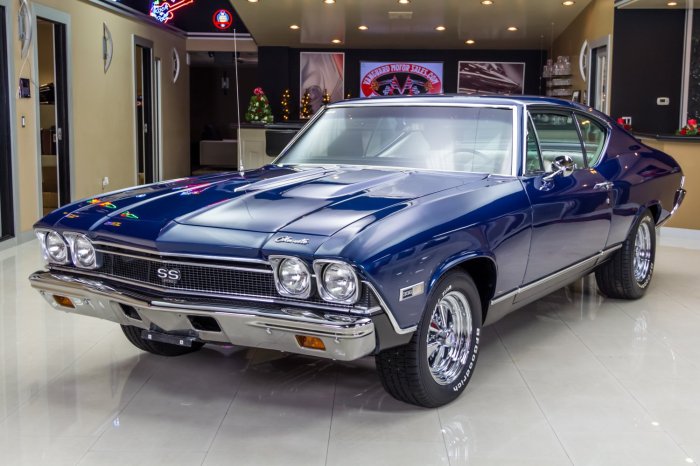
The 1968 Chevrolet Chevelle is a car that embodies the spirit of the era. Its sleek lines and bold styling made it a popular choice for drivers of all ages. The Chevelle’s design was a departure from the previous year’s model, featuring a more modern and aggressive look.
Model Variations
The 1968 Chevelle was available in a variety of trim levels, each with its own unique features. The following table provides a brief overview of the different models and their key characteristics:
| Model | Trim Level | Engine Options | Notable Features |
|---|---|---|---|
| Chevelle Malibu | Base model | 250 cu in (4.1 L) straight-six, 307 cu in (5.0 L) V8, 327 cu in (5.4 L) V8 | Standard features included bucket seats, a center console, and a full-length floor console. |
| Chevelle SS 396 | Performance model | 396 cu in (6.5 L) V8 | Features included a blacked-out grille, special badging, and performance tires. |
| Chevelle Concours | Luxury model | 250 cu in (4.1 L) straight-six, 307 cu in (5.0 L) V8, 327 cu in (5.4 L) V8 | Features included a vinyl roof, special interior trim, and a wood-grain steering wheel. |
| Chevelle Greenbrier | Station wagon | 250 cu in (4.1 L) straight-six, 307 cu in (5.0 L) V8, 327 cu in (5.4 L) V8 | Features included a spacious cargo area and a variety of seating configurations. |
Iconic Design Elements
The 1968 Chevelle’s design was a bold departure from its predecessors, featuring a more modern and aggressive look. The sharp lines and distinctive grille made it instantly recognizable.
[Image: A 1968 Chevrolet Chevelle with a caption describing the iconic design elements, emphasizing its distinctive styling.]
The “Coke Bottle” Design, 1968 Chevrolet Chevelle
The 1968 Chevelle is known for its distinctive “Coke bottle” design, a styling trend that was popular in the late 1960s. The Chevelle’s body curves inward at the doors, creating a narrow waistline that resembles the shape of a Coke bottle.
This design element was intended to give the car a more athletic and dynamic appearance.
[Image: A close-up of a 1968 Chevelle’s body, showcasing the “Coke bottle” design with a caption explaining its significance.]
Epilogue

The 1968 Chevrolet Chevelle stands as a testament to the golden age of American muscle cars. Its enduring legacy continues to inspire automotive enthusiasts and collectors worldwide. From its powerful engines to its timeless design, the Chevelle remains a symbol of American automotive excellence and a reminder of a bygone era when performance and style reigned supreme.
Whether you’re a seasoned collector or a newcomer to the world of classic cars, the 1968 Chevelle offers a captivating blend of history, performance, and style that is sure to leave a lasting impression.